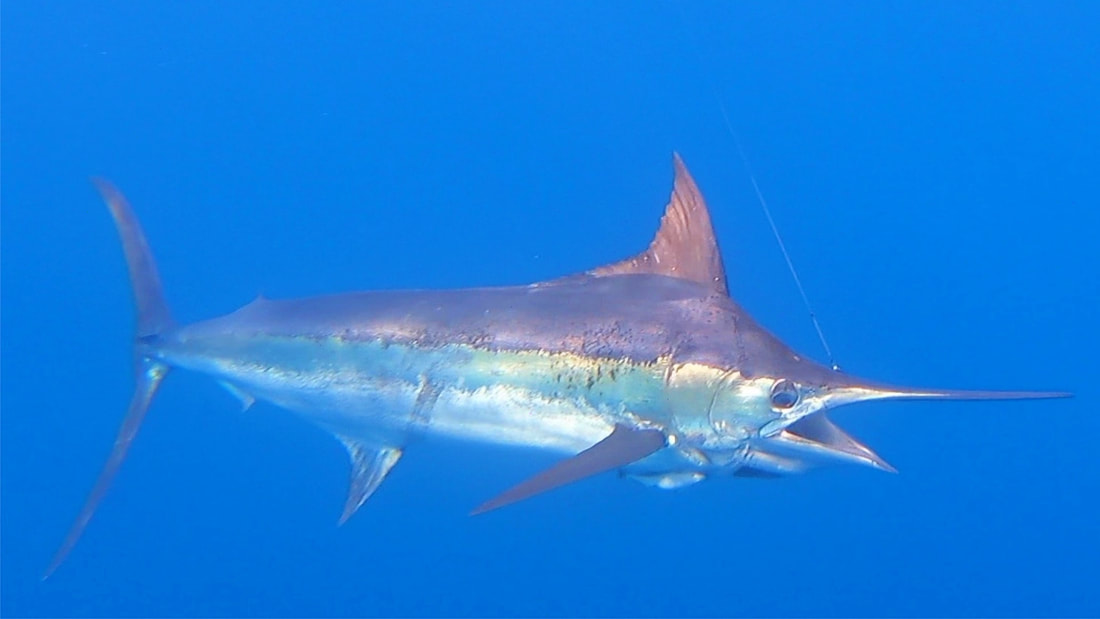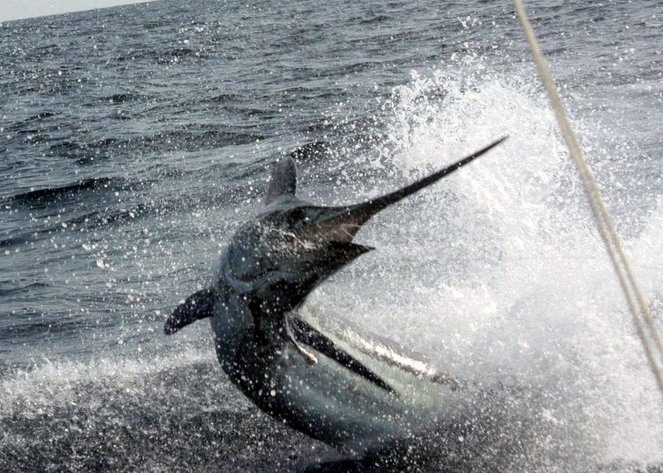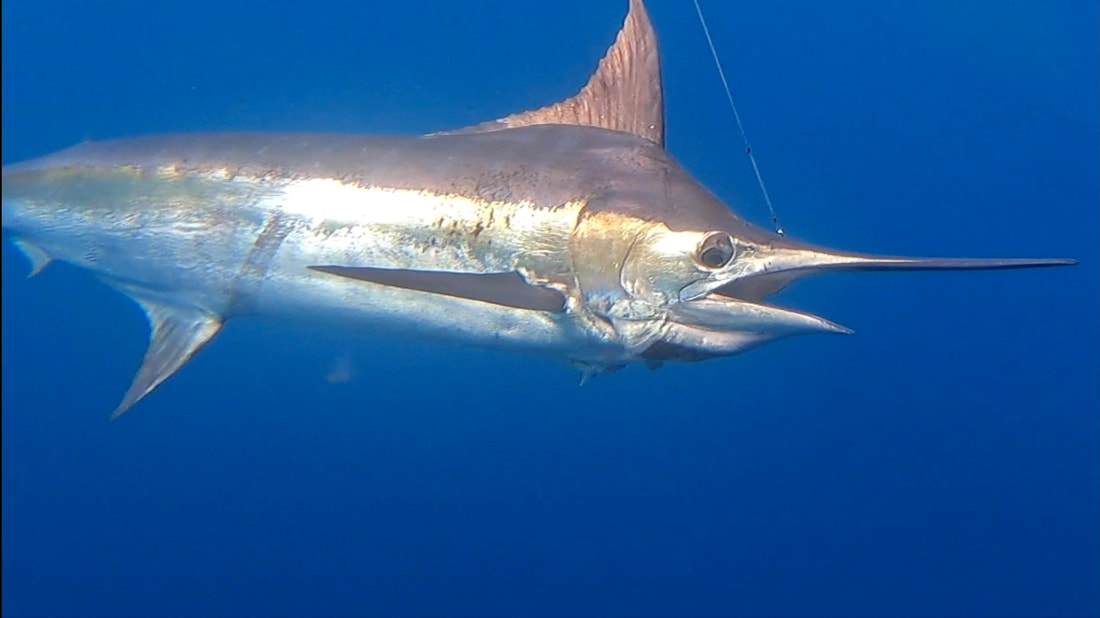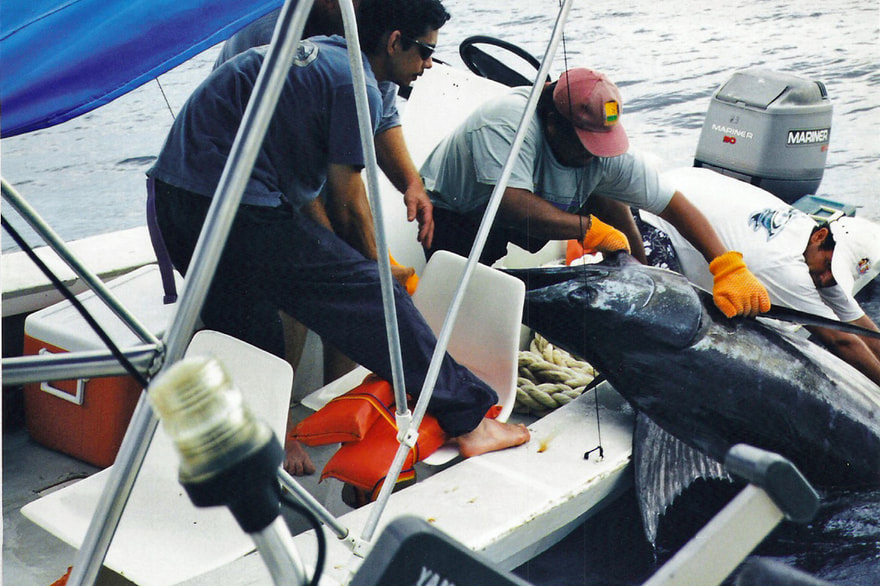Blue Marlin
Makaira mazara
HOME
Other Species
Blue Marlin and their cousins the Black Marlin are the largest game fish in the world, with large specimens sometimes exceeding 1,000 pounds. There is no sight more awe-inspiring in fishing than the sight of these massive fish leaping into the air right behind your boat when they are hooked; they are the apex sport fish. Because they are large apex predators you generally have to hunt for a long time to find one, but when you hook one you forget how long you had to wait. Blue Marlin can be distinguished from Black Marlin not by their color, but by whether they fold in their pectoral fins. Blue Marlin usually fold in their pectoral fins when jumping, while Black Marlin do not once they are adults. Black Marlin have slightly different body shapes, with more weight around the head and shoulder area while Blue Marlin are more uniform.
Blue Marlin are found primarily in tropical portions of the Indian and Pacific oceans, but can stray to other seas as well. You usually need a large boat to pursue them as they tend to be found far offshore.
Blue Marlin roam the oceans looking for fish and cephalopods to feed on. They rarely congregate in any numbers, so there is often a lot of time spent looking for them. Fish over 300lbs are nearly always female.
Blue Marlin Pound for Pound Fight Rating - 10 out of 10 on the Saltwater Scale
Blue Marlin, along with Black Marlin and Swordfish, are the most powerful gamefish in the ocean. They can go on extremely large runs and empty the largest reels if you don't chase them. If they head straight down, you just have to pray you have enough line. They make violent leaps and often throw the hook. These offer some of the toughest fights in the ocean.
Blue Marlin Culinary Rating - Medium
I have released all the Blue Marlin I have caught, but I have eaten them on a couple of occasions. Marlin obviously provide a ton of meat, and it holds together well when cooked a variety of ways. Some people like to smoke Marlin or make jerky with it.
Makaira mazara
HOME
Other Species
Blue Marlin and their cousins the Black Marlin are the largest game fish in the world, with large specimens sometimes exceeding 1,000 pounds. There is no sight more awe-inspiring in fishing than the sight of these massive fish leaping into the air right behind your boat when they are hooked; they are the apex sport fish. Because they are large apex predators you generally have to hunt for a long time to find one, but when you hook one you forget how long you had to wait. Blue Marlin can be distinguished from Black Marlin not by their color, but by whether they fold in their pectoral fins. Blue Marlin usually fold in their pectoral fins when jumping, while Black Marlin do not once they are adults. Black Marlin have slightly different body shapes, with more weight around the head and shoulder area while Blue Marlin are more uniform.
Blue Marlin are found primarily in tropical portions of the Indian and Pacific oceans, but can stray to other seas as well. You usually need a large boat to pursue them as they tend to be found far offshore.
Blue Marlin roam the oceans looking for fish and cephalopods to feed on. They rarely congregate in any numbers, so there is often a lot of time spent looking for them. Fish over 300lbs are nearly always female.
Blue Marlin Pound for Pound Fight Rating - 10 out of 10 on the Saltwater Scale
Blue Marlin, along with Black Marlin and Swordfish, are the most powerful gamefish in the ocean. They can go on extremely large runs and empty the largest reels if you don't chase them. If they head straight down, you just have to pray you have enough line. They make violent leaps and often throw the hook. These offer some of the toughest fights in the ocean.
Blue Marlin Culinary Rating - Medium
I have released all the Blue Marlin I have caught, but I have eaten them on a couple of occasions. Marlin obviously provide a ton of meat, and it holds together well when cooked a variety of ways. Some people like to smoke Marlin or make jerky with it.
Blue Marlin Tackle
Most fishermen will likely find it easiest to just charter a boat that has the appropriate tackle for these monsters. I personally like to bring my own when I can, and when I do I bring a heavy trolling outfit (I like to use an Accurate Platinum ATD 50 trolling reel and a custom roller rod) loaded with at least 130lb braid and a 300lb mono leader (maybe less if fishing live bait). You don’t want to go through all of the expense of going to a distant location and hooking the fish of a lifetime and then losing it because you pinched pennies on the tackle.
Blue Marlin Techniques
There are two main ways that people catch Blue Marlin – slow trolling large live or dead skipping baits like skipjack tuna or faster trolling with large skirted marlin lures. I have no source to back this up but I would imagine that at least 80% of all Blue Marlin are landed using one of those two techniques.
BlueMarlin Lures
Most marlin hunters use rubber skirted lures such as Moldcraft soft heads, Black Barts, and Pakulas.
These are dragged behind the boat at varying distances until a marlin is sighted coming up to look at the lures. At that point you can either hope that it bites or drop back a large live or dead bait to see if you can entice it with that.
Blue Marlin Baits
Most fish in the 1-10lb size range that are found offshore where the marlin are will make good live baits. Probably the most common are smaller members of the tuna family such as Skipjack Tuna. These are caught by trolling small rubber skirts or other lures and then quickly placed alive in “tuna tubes” (Note: if you are thinking of chartering a boat to fish for blue marlin it is generally advisable to get a boat with tuna tubes so that this kind of live bait fishing is an option). Once you have enough baits you can bridle them and slow troll them until something smashes them. A good approach is to troll one bait on each side of the boat and then have another one down deep on a downrigger if you have one. Most captains now use circle hooks to get a better hookset and ensure a cleaner release.
When a fish takes the bait you can ease the tension on the reel until the line starts going out at a good clip that and you can’t stop the spool with your thumb. That usually means the marlin has taken the bait. At that point the captain can gun the engine and (if you are using a circle hook) you can steadily increase the drag tension in order to set the hook. Sometimes marlin play around with the baits by whacking them with their bills, other times they swallow them immediately and head for Guam (note: in Guam they head the other way). You have to pay attention and feel what is going on with the bait through the line. Marlin have tough mouths and it can be difficult to drive a hook in, which is another reason to use circle hooks.
Most fishermen will likely find it easiest to just charter a boat that has the appropriate tackle for these monsters. I personally like to bring my own when I can, and when I do I bring a heavy trolling outfit (I like to use an Accurate Platinum ATD 50 trolling reel and a custom roller rod) loaded with at least 130lb braid and a 300lb mono leader (maybe less if fishing live bait). You don’t want to go through all of the expense of going to a distant location and hooking the fish of a lifetime and then losing it because you pinched pennies on the tackle.
Blue Marlin Techniques
There are two main ways that people catch Blue Marlin – slow trolling large live or dead skipping baits like skipjack tuna or faster trolling with large skirted marlin lures. I have no source to back this up but I would imagine that at least 80% of all Blue Marlin are landed using one of those two techniques.
BlueMarlin Lures
Most marlin hunters use rubber skirted lures such as Moldcraft soft heads, Black Barts, and Pakulas.
These are dragged behind the boat at varying distances until a marlin is sighted coming up to look at the lures. At that point you can either hope that it bites or drop back a large live or dead bait to see if you can entice it with that.
Blue Marlin Baits
Most fish in the 1-10lb size range that are found offshore where the marlin are will make good live baits. Probably the most common are smaller members of the tuna family such as Skipjack Tuna. These are caught by trolling small rubber skirts or other lures and then quickly placed alive in “tuna tubes” (Note: if you are thinking of chartering a boat to fish for blue marlin it is generally advisable to get a boat with tuna tubes so that this kind of live bait fishing is an option). Once you have enough baits you can bridle them and slow troll them until something smashes them. A good approach is to troll one bait on each side of the boat and then have another one down deep on a downrigger if you have one. Most captains now use circle hooks to get a better hookset and ensure a cleaner release.
When a fish takes the bait you can ease the tension on the reel until the line starts going out at a good clip that and you can’t stop the spool with your thumb. That usually means the marlin has taken the bait. At that point the captain can gun the engine and (if you are using a circle hook) you can steadily increase the drag tension in order to set the hook. Sometimes marlin play around with the baits by whacking them with their bills, other times they swallow them immediately and head for Guam (note: in Guam they head the other way). You have to pay attention and feel what is going on with the bait through the line. Marlin have tough mouths and it can be difficult to drive a hook in, which is another reason to use circle hooks.



